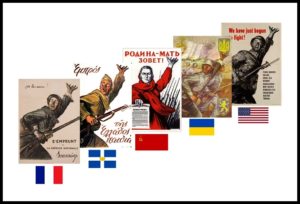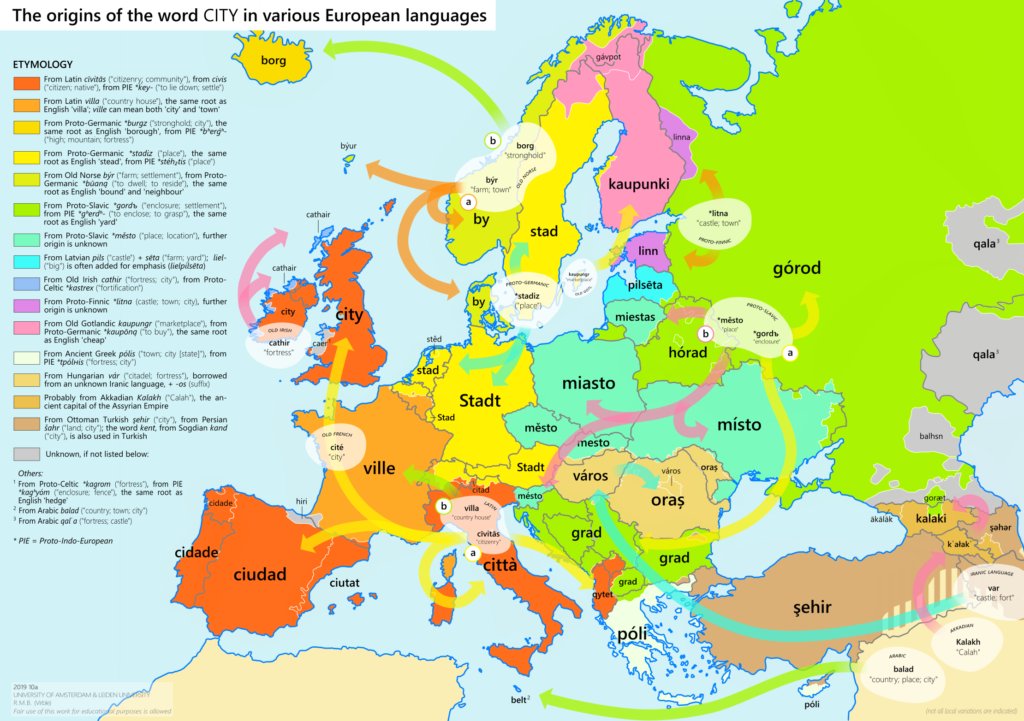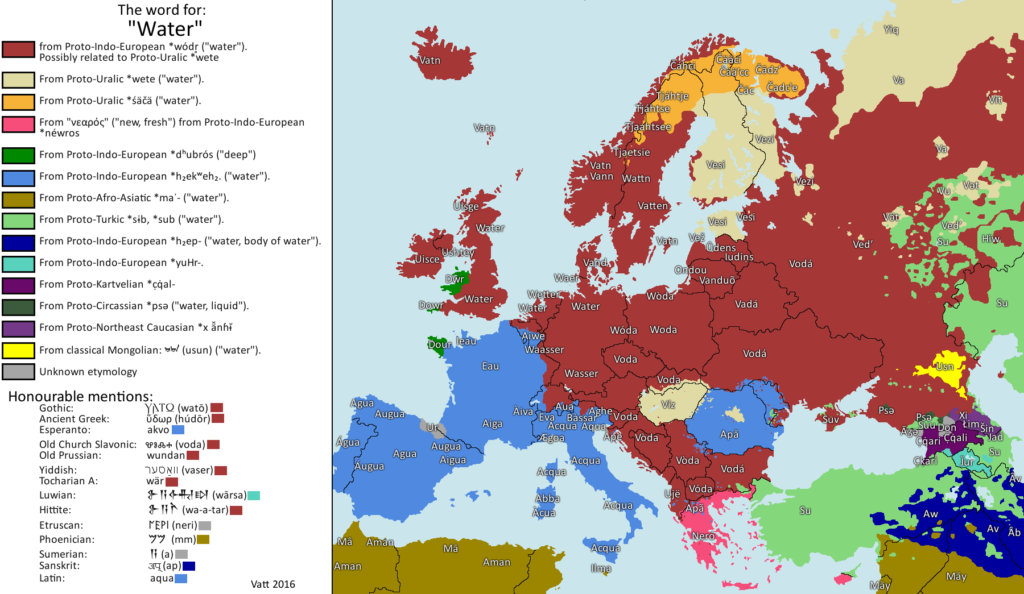Language Bone
Language is an innate human trait. It is the real economy of the human race. It is the connective tissue of all activity. Like proteins folded for biological results, language “proteins” create memes that poison, inspire, outrage and heal as desired.
There are THOUSANDS of different languages and dialects in India alone. Embedded in each one, like a skeleton, is our common inventory of things we need to discuss. In a shared language we conduct our business with a speed and dexterity that is only possible when we can take meanings for granted. Without a shared language, the conversation becomes like archeology, we painstakingly dig out meanings from our common inventories of human stuff and clarify them with pointing and miming. It can be exhausting and still leave us with ambiguous, tentative conclusions.
In that situation, we have a minimal, shared global language for taking care of existential business without words. Like dogs and cats, we have symbolic body language communicating all sorts of things about how we feel. There are global facial expressions, gestures, and vocal tones indicating things like I am harmless, friendly, afraid, confused, sick, etc. These are universal enough that we can read each other pretty easily about simple things without a spoken language in common. * Continue reading
Part 1. There is no clean break between stories lived, dreamed, or told.
Our world is a measureless ocean of stories. Some are untouchable, uneditable, unmeeting parallels, distant in space/time. Some are sliding intimately through and around each other, mutually editing in motion.
We are stories who sprout further stories. Each of us is a tale partly told. We are suspenseful and unfinished. We are story-birds and every feather, large or small is someone or something else. Every chance meeting, ambition, fear, and plan is a story within our story. We are narrative fractals. Particles to self-observation, waves to outsiders. We all have public stories that we wear like expensive coats and secret stories in our silent flesh like pearls or tumors. Intimacy invites the listener or reader inside, then downward, past the public exhibits into the little-seen rooms and closer to the story you wouldn’t even know how to tell another person. Some are so private we don’t even grant ourselves clearance. Out of loyalty, pride or fear, some tales serve life sentences in solitary confinement, dying alone in the heart of the only witness.
To hear a story is to be offered a ride in it with an option to buy. Each telling generates new participants and versions. Stories are medicine, though whether they are magical elixir, placebo or poison is determined mostly by the state of the listener. To know something is to tell it to yourself, and hear it permanently.
The branching stories of our local neighborhoods mingle and tangle with those of our family, friends, loves, and enemies; familiar as those childhood streets until they fade in the gray distance of untold strangers.
Once upon a time…
Stories are the universal means to humanity’s ends. Stories are the acid test proof of humanity the species. They are the medium of culture, family, battle-plans, jokes, memes, and inventions. We could not conduct any of our signature business without them.
Therefore, to imagine a time of people before there were stories is sheer, well… fiction. No such animal existed. After our last common ancestor, there were wicked smart primates of many kinds, but the first people and the first stories are simultaneous, mutual creations, creating each other. The outside borders of humanity are where the stories cut off suddenly in the vacuum-like silence of animals*, plants and the great unknown. We exist in an atmosphere of exhaled and inhaled narrative. In the beginning…was the beginning.
The System:
Shared Narrative is the economy of human activity and stories are the coin. Underlying any economy is an agreement about how it works and the recognition of common units of exchange. A system of exchange must be understood well enough to be taken for granted.
In the narrative economy, I believe this means that the story elements used in a tale being told by A initiate a request inside the listener, B, to load their corresponding copy of that element in order to recognize meaning. We must each have our own copy of ABC or the alphabet wouldn’t work.
A narrative structure in the telling must match up with a corresponding structure in the listening. These elements must land, like drug or scent molecules, on matching neuroreceptors. If not, drugs would have no predictable common effect on us and we couldn’t say things like: “Is that cigarette smoke I smell?” We easily refer to the smell of fall leaves, wet dog, or shit because we can take the same recognition system for granted. Continue reading
5000 years later many names have recognizable roots and traces.
A darkly poignant human story of lost knowledge and cruelty, connecting prehistory to today.
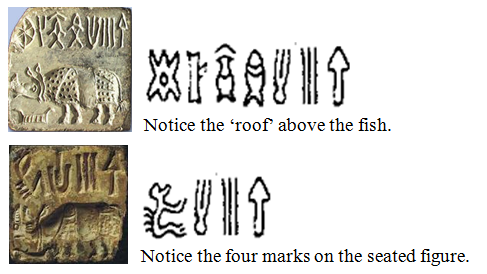
This picture is a comparison between ancient Harappan script and Easter island Rongorongo characters. They are unmistakably related. This is a bit of a mind fuck because they are about as far apart as possible both on the surface of the earth and over the length of human time. 1
The (Indus valley) Harappan culture was astoundingly advanced and sophisticated (I’ll explore how advanced in a later post). It began and flowered ~8 thousand years ago 2 during the eye-blink brevity of the neolithic agricultural transformation of humanity from the old stone age to new. 3 We still cannot understand the script but apparently, it WAS understood by the priestly caste on Easter island, where it was considered sacred.
In the 1800’s Peru took half the Easter island population as slaves including everyone who knew how to interpret the symbols. The survivors took to obsessively copying the characters onto scraps of wood. They wanted to keep the language alive but it was now only an empty, outward form, cut off from meaning. It drifted into mere decoration and when the missionaries arrived, they pressured the survivors to burn all the old writing and make a clean start with Jesus.
1 It also correlates strongly to proto- Chinese!
2 Even if we chop a couple of thousand years off this timeline to correct for exaggeration or error, the continuation of this alphabet/symbol system from Mohenjo-Daro to Rapa-Nui is the longest cultural transmission ever: comparable to modern Egyptians using hieroglyphics.
We lived “Paleolithically” for two hundred thousand years…then took just three thousand years to drop our life strategy as a whole species and throw a new one together. OK, not as a whole species, but the dribs and drabs of hunter-gatherer humanity that carried on are the microscopic exception to the new rule.

The Part that Sounds Sensible
- The Learning Perspective: B.F. Skinner is the theorist behind the flat mechanics of the learning perspective. He argued that adults shape the speech of children by reinforcing the babbling of infants that sound the most like words and that children learn language from punishment and reinforcement. B.F.Skinner was a behaviorist who’s only tool was a hammer and theorized that every type of behavior was a nail. His theory of language through conditioning briefly dumbed down the whole conversation.
- Interactionist Theory: Interactionists argue that language development is both biological and social; That language learning is influenced by the desire of children to communicate with others. This drive to communicate and share is a powerful motivator. The mistake is concluding that this motivating desire is a causal force rather than a related and helpful one.
- The Nativist Perspective: Developed by Noam Chomsky. He argues that humans are biologically programmed to gain knowledge and that all humans have a language acquisition device (LAD). The LAD contains knowledge of grammatical rules common to all languages. The LAD also allows children to understand the rules of whatever language they are listening to. Chomsky suggests that universal language acquisition behaviors in humans reveal that it is innate. Obvious but unseen till Chomsky.
- The Language Instinct: A 1994 book by Steven Pinker. He argues that humans are born with an innate capacity for language. Pinker sees language as an ability unique to humans, produced by evolution to solve the specific problem of communication among social hunter-gatherers. He compares language to other species’ specialized adaptations such as spiders’ web-weaving or beavers’ dam-building behavior, calling all three “instincts”. In calling language an instinct, Pinker means that it is not a human invention in the sense that metalworking and even writing are. While only some human cultures possess these technologies, all cultures possess language.
You (make-believe loyal reader ) know I am absolutely sure that language is innate. There is a circular but sensible reason it is innate. Everyone has to talk because everyone else does. Language is an essential survival trait in a social species. That means It is too important to leave it up to us. Can you imagine if children had to depend on parents to ensure that they could speak? There would be a large random distribution of mute humans everywhere, trying to get by. The same forces that guarantee the action of your heart and lungs provide you with an automatic phase of intense language acquisition that clicks on when your body says it is time. Continue reading
Nearly half the world’s population speaks one of the languages derived from a single ancient tongue, dubbed Proto-Indo-European, or PIE. Mainstream scholarship places the Proto-Indo-Europeans in the forest-steppe zone immediately to the north of the western end of the Pontic-Caspian steppe in Eastern Europe. Or more simply a bit north of the Black Sea. Linguists have long argued that PIE first spread from there to Europe some 6,000 to 5,000 years ago. Some archaeologists would extend the time depth of PIE to the middle Neolithic (5500 to 4500 BC) or even the early Neolithic (!) (7500 to 5500 BC). An alternative hypothesis posits that PIE spread some 8,000 years ago from what is now Turkey, after the introduction of agriculture into those regions. In other words, a bit south of the Black Sea. The latest evidence from evolutionary biology and ancient DNA samples, rather than settling the issue, is adding to the controversy.
This flow chart or family tree should be read from the lower left-hand corner up and outward ending at the top left and top right.
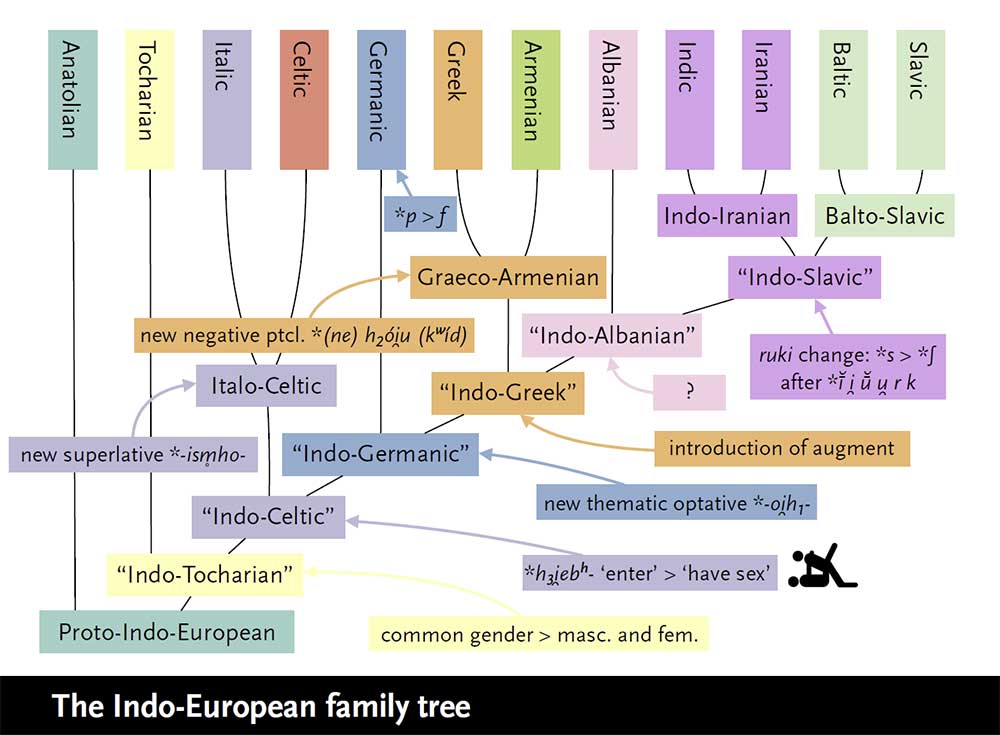
I love that the only image to make the cut here is two icon people having sex. Anyway, wherever the point of origin, the evolution of PIE into dozens of languages appears to be solid science using the technique of linguistic reconstruction. Below is an attempt to reconstruct the sounds of spoken PIE based on this research.
It’s fascinating to look over proto Indo-European vocabulary and see how many of the words bear a trace of resemblance to current languages. Here is a big list of nouns.
I believe there is an essential connection between this rapid spread of a common root language and the tumultuous viral lifestyle shift from Paleolithic to Neolithic. A bit about that can be found here: Sea Change. A related and fascinating piece of this story is that many fairy tales, even some still in use today, turn out to be over 6000 years old. This places them inside this the same zone time zone as the spread of PIE and the mass migration from tribes to settled, far larger communities. Here’s a reference to that discovery.
(http://www.sciencemag.org/news/2016/04/some-fairy-tales-may-be-6000-years-old)
(Not by me, all credit goes to original authors of record – Just filleting an interesting article for the good bits. Link to the full article above right.)
By David Shultz Apr. 22, 2016 , 10:15 AM
A new study, which treats these fables like an evolving species, finds that some may have originated as long as 6000 years ago.
The basis for the new study, published in Royal Society Open Science, is a massive online repository of more than 2000 distinct tales from different Indo-European cultures known as the Aarne–Thompson–Uther Index, which was compiled in 2004. Although not all researchers agree on the specifics, all modern Indo-European cultures (encompassing all of Europe and much of Asia) descended from the Proto-Indo-European people who lived during the Neolithic Period (10,200 B.C.E.–2000 B.C.E.) in Eastern Europe. Much of the world’s modern language is thought to have evolved from them.
To conduct the study, Jamshid Tehrani, an anthropologist at Durham University in the United Kingdom, and colleagues scanned the repository. They limited their analysis to tales that contained magic and supernatural elements because this category contained nearly all the famous tales people are familiar with. This narrowed the sample size to 275 stories, including classics such as Hansel and Gretel and Beauty and the Beast.
But tracing these tales back through time is no easy task. There are scant historical records, and many of the fables began as oral stories that left no written versions. So the researchers used statistical methods similar to those employed by biologists to trace species lineages back through the branching tree of evolution based only on modern DNA sequences.
This approach allowed the researchers to trace certain tales, such as The Smith and the Devil, which tells the story of a blacksmith who makes a deal with the devil in exchange for unmatched smithing prowess, back thousands of years—all the way to the Proto-Indo-European people. If the analysis is correct, it would mean the oldest fairy tales still in circulation today are between 2500 and 6000 years old. Other stories seem to be much younger, appearing for the first time in more modern branches of the language tree.
In a new dispatch, published this month in Current Biology, he ruminates on what allows these stories to stand the test of time. “What really interests me is why these cultural forms exist. Why is it that fairy tales, art, songs, poems, why do these things seem to have such longevity?”
